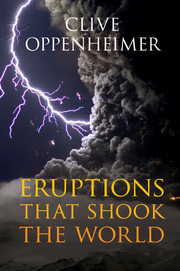Book contents
- Frontmatter
- Contents
- Preface
- Acknowledgements
- 1 Fire and brimstone: how volcanoes work
- 2 Eruption styles, hazards and ecosystem impacts
- 3 Volcanoes and global climate change
- 4 Forensic volcanology
- 5 Relics, myths and chronicles
- 6 Killer plumes
- 7 Human origins
- 8 The ash giant/sulphur dwarf
- 9 European volcanism in prehistory
- 10 The rise of Teotihuacán
- 11 Dark Ages: dark nature?
- 12 The haze famine
- 13 The last great subsistence crisis in the Western world
- 14 Volcanic catastrophe risk
- Appendix A Large eruptions
- Appendix B Further reading and data sources
- References
- Index
- References
References
Published online by Cambridge University Press: 01 June 2011
- Frontmatter
- Contents
- Preface
- Acknowledgements
- 1 Fire and brimstone: how volcanoes work
- 2 Eruption styles, hazards and ecosystem impacts
- 3 Volcanoes and global climate change
- 4 Forensic volcanology
- 5 Relics, myths and chronicles
- 6 Killer plumes
- 7 Human origins
- 8 The ash giant/sulphur dwarf
- 9 European volcanism in prehistory
- 10 The rise of Teotihuacán
- 11 Dark Ages: dark nature?
- 12 The haze famine
- 13 The last great subsistence crisis in the Western world
- 14 Volcanic catastrophe risk
- Appendix A Large eruptions
- Appendix B Further reading and data sources
- References
- Index
- References
- Type
- Chapter
- Information
- Eruptions that Shook the World , pp. 369 - 384Publisher: Cambridge University PressPrint publication year: 2011



